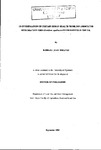AN INVESTIGATION OF CERTAIN HUMAN HEALTH PROBLEMS ASSOCIATED WITH BRACKEN FERN (Pteridium aquilinum) ENVIRONMENTS IN THE U.K.
| dc.contributor.author | SHEAVES, BARBARA JOAN | |
| dc.contributor.other | Faculty of Science and Engineering | en_US |
| dc.date.accessioned | 2013-10-18T11:22:46Z | |
| dc.date.available | 2013-10-18T11:22:46Z | |
| dc.date.issued | 1995 | |
| dc.identifier | NOT AVAILABLE | en_US |
| dc.identifier.uri | http://hdl.handle.net/10026.1/2228 | |
| dc.description.abstract |
Bracken environments harbour the sheep tick (Ixodes ricinus), known vector of a number of diseases. Initial investigation indicated the presence of sheep ticks infected with the Lyme disease spirochaete Borrelia burgdorferi on open moorland areas of the North York Moors and the moorland areas of the South West of the U.K. Some aspects of the problem of Lyme disease on U.K. moorlands were explored in this study. A survey through the summer of 1993 of people using the North York Moors, Dartmoor and the Quantock Hills in Somerset for both work and leisure activities revealed a very high proportion of people (76% of respondents had not heard of Lyme disease) who were unaware of the risk of Lyme disease or of how they might reduce that risk. An examination of three moorland vegetation communities as optimal tick habitats suggested that immature ticks are less dense on heather dominated communities than on either bracken or on Vaccinium dominated communities, and that this may be influenced by the fauna using heather dominated areas. Vaccinium sites showed high densities of all life stages of the sheep tick, as did bracken dominated sites. Ticks were collected throughout the winter months on South Western sites, but not on the North York Moors, emphasising the year round risk from infected ticks in the South West of the U.K. Vegetation management practices as tick control or reduction options in these moorland areas were investigated. Asulam spraying on bracken almost totally removed the above ground frond cover, substantially reduced live buds on the rhizome, but failed to reduce the rhizome dry weight. The density of frond cover was not affected by cutting, height and dry frond weight were reduced, live rhizome buds reduced in number and rhizome dry weight reduced. Short term control of bracken fronds was achieved by both treatments, but neither treatment provided sufficiently conclusive results on which to base long term recommendations. Comprehensive plans for after care on treated sites need to be in place before treatment is carried out. Tick densities were recorded over a two year period on these treated bracken sites. There was a proportional reduction in all tick life stages between 1993 and 1994 on sites sprayed with asulam and on cut sites compared with control sites. Although not statistically significant these results suggested that the methods of bracken control investigated in this study could influence sheep tick densities in the short term. | en_US |
| dc.language.iso | en | en_US |
| dc.publisher | University of Plymouth | en_US |
| dc.title | AN INVESTIGATION OF CERTAIN HUMAN HEALTH PROBLEMS ASSOCIATED WITH BRACKEN FERN (Pteridium aquilinum) ENVIRONMENTS IN THE U.K. | en_US |
| dc.type | Thesis | |
| dc.identifier.doi | http://dx.doi.org/10.24382/3799 |
Files in this item
This item appears in the following Collection(s)
-
01 Research Theses Main Collection
Research Theses Main


